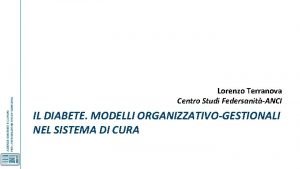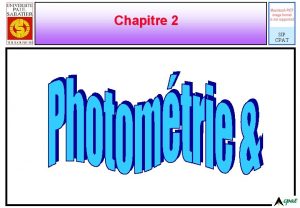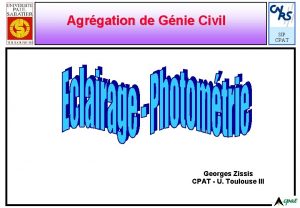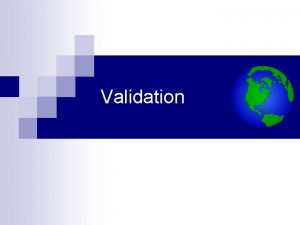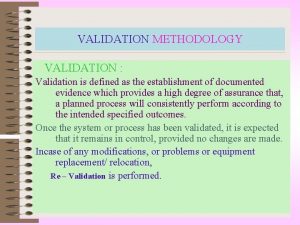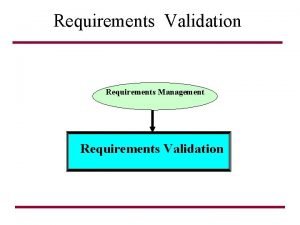CPAT Validation Study Victoria Terranova Ph D Kyle



















- Slides: 19

CPAT Validation Study Victoria Terranova, Ph. D & Kyle Ward, Ph. D Pretrial Executive Network – Quarterly Meeting 08/21/20

CPAT Validation Study Purpose: Empirically assess the validity, impact, and implementation of the Colorado Pretrial Assessment Tool (CPAT) to improve the effectiveness of this instrument at assigning a defendant’s risk to the public’s safety and successfully completing the trial process. Goal: The goal is to improve the effectiveness of the CPAT at assessing a defendant’s pretrial risk to return to court and/or remaining law abiding. Participating pretrial service agencies: Boulder, Denver, Garfield, Larimer, Mesa, Pueblo & Weld Phases: Phase 1 (Jan 2018 – June 2018) Retroactive Validation & Implementation survey Phase 2 (June 2018 – August 2018) Focus groups and on-site observation Phase 3 (August 2018 – June 2020) Pilot test of modified tool, the CPAT-R 2

Phase 1 – Retroactive Validation and Survey Findings • The CPAT validated. • Modifying risk category designation and risk factors could improve the predictive performance of the CPAT. • Weighting and scoring methods do not interfere with the predictive performance. • Perceived implementation considerations: lack of account of prior FTA, lack of substance abuse risk factor, reliability of self-report items, overload of Category 2, lack of account of current charge severity, buy-in 3

Phase 2 – Observation and Focus Groups Findings • Themes about perceived implementation considerations • Role of pretrial risk assessment • How the tool is used • Consideration of other factors, independent of the risk assessment • Pretrial supervision decisions • Training and education 4

Phase 3 – Pilot Study CPAT-R Pilot Study • 3 -months and 1 -year follow-up Pilot CPAT-R Construction • Selection variables • Weighting/features Data Sources • Pilot survey • Pretrial agency records • CO Courts • Denver Municipal Court • Criminal history records 5

Pilot CPAT-R Score (range 0 -22) Definition Employment/education 0/2 Self-reported employment or current student at the time of arrest. (0 = yes, 2 = no). Time at current residence 0/1 Self-reported time living at current residence. (0 = 1 year or longer, 1 = less than 1 year or no residence). Problems with alcohol or drugs 0/1 Self-reported current or past problems with alcohol and/or drugs (0 = no, 1 = yes). Prior Arrests 0/3 Prior arrests confirmed with criminal history records (0 = 1 or less, 3 = 2 or more). Arrest in the last year 0/3 Arrest within the last year confirmed with criminal history records (0 = none, 3 = 1 or more). Age at first arrest 0/1 Defendant age at first arrest confirmed with criminal history (0 = 21 yoa or older, 1 = 20 yoa or younger). Prior FTA 0/3 Prior FTA confirmed with court history records (0 = none, 3 = 1 or more). FTA in the last year 0/3 FTA within the last year confirmed with court history records (0 = none, 3 – 1 or more). 0/1/2 Pending charge at arrest (0 = none, 1 = misdemeanor charge(s) only, 2 = at least 1 felony charge). Risk Factor Pending charge at arrest Active warrant 0/2 Prior violent arrest 0/1 Active warrant at arrest (0 = no, 2 = yes). Prior violent arrest (0 = none, 1 = at least 1). 6

Pilot Analysis Validation & Calibration • CPAT-R, CPAT & CPATR-SV validated and calibrated. • CPAT-R best performing tool. Bias • Modifications • Prior violent arrest • Time at current residence Self-report reliability and features • Self-report risk factors low to moderate agreement with official records. • Modifications • Prior alcohol or drug Samples • Validation/Training • Test 7

Pilot - Validation Table 17. Full Sample – Released pretrial defendants AUC scores Pilot CPAT-R AUC (BC CI) CPAT – AUC (BC CI) CPATR – SV (BC CI) AUC diff, pvalue New Arrest and/or FTA. 65* (. 62 -. 68) . 60* (. 57 -. 62) . 62* (. 59 -. 65) <. 001 New Arrest. 59* (. 56 -. 63) . 57* (. 53 -. 60) . 56* (. 52 -. 60) <. 001 FTA. 66* (. 63 -. 69) . 60* (. 57 -. 63) . 64* (. 61 -. 67) <. 001 Outcome Primary Secondary Violent . 57 (. 44 -. 66) . 57 (. 44 -. 67) . 55 (. 43 -. 64) . 28 DV or order Violation . 52 (. 42 -. 61) . 55 (. 46 -. 64) . 51 (. 40 -. 60) . 51 Serious. 60* (. 55 -. 64) . 58* (. 53 -. 62) . 57* (. 52 -. 61) <. 001 Other. 60* (. 53 -. 66) . 55 (. 49 -. 62) . 55 (. 49 -. 61) <. 001 FTA – No. 64* (. 61 -. 67) . 60* (. 56 -. 63) . 62* (. 58 -. 65) <. 001 . 57 (. 47 -. 66) . 55 (. 47 -. 63) . 56 (. 47 -. 66) . 86 FTA – High. 68* (. 63 -. 72) . 58* (. 53 -. 62) . 64* (. 59 -. 69) <. 001 FTA – Low * = Estimate is likely beyond chance a) Confidence Intervals (bootstrap 1000) n = 1, 486 8

Pilot - Calibration 9

Pilot – Bias Analysis Sub-groups Analyses • Race/Ethnicity • White • Black • Hispanic • Accuracy Equity • Gender • Male • Female • Predictive Parity • Residential Status • Homeless • Housed • Predictive performance across sub-groups • Systematic differences • Assessment Errors • False Positive Rate • False Negative Rate • High/Low risk • Descriptive differences • Sub-group membership & Predictive Performance • Statistical interaction 10

Pilot – Accuracy Equity Table 21. Validation sample – Released pretrial defendants sub-groups Average CPAT-R Score (SD) Baserate for New Arrest and/or FTA (SD) New Arrest/FTA AUC (BC CI) White (n = 656) 9. 03 (5. 45) . 31 (. 46) . 70* (. 65 -. 74) Black (n = 186) 10. 34 (4. 81) . 30 (. 46) . 60* (. 52 -. 69) Hispanic (n = 331) 10. 13 (5. 36) . 35 (. 48) . 64* (. 58 -. 70) Male (n = 914) 9. 83 (5. 28) . 33 (. 47) . 66* (. 63 -. 70) Female (n = 272) 9. 99 (5. 63) . 36 (. 48) . 62* (. 55 -. 69) Homeless (n = 206) 12. 49 (4. 85) . 43 (. 49) . 62* (. 55 -. 70) Housed (n = 1, 060) 9. 16 (5. 34) . 30 (. 46) . 67* (. 63 -. 70) Sub-group Race/ethnicitya Sexb Residential Statusc * = Estimate is likely beyond chance a) X 2 = 4. 88; β = -. 16, BC CI: -. 32 - -. 02) b) X 2 = 1. 27; β = -. 09, BC CI: -. 43 -. 19) c) X 2 =. 90; β = -. 19, BC CI: -. 51 -. 13) d) Confidence Intervals (bootstrap 1000) n = 1, 266 11

Bias – No Prior Violence Race/ethnicity Table 22. Validation sample – Race/ethnicity assessment errors (see Final Report, pg. 50 for full table) Modification False Positive Rate False Negative Rate W B H Pilot CPAT-Rb . 24 . 37 . 29 . 52 . 55 . 48 No prior violent arrestc . 33 . 29 . 37 . 51 a) White n = 656, new arrest/ FTA baserate =. 31; Black n = 186, new arrest/FTA baserate =. 30; 1, 173; Hispanic n = 331, new arrest/FTA baserate =. 35. b) The optimal high/low threshold is risk score 12, β =. 42, p<. 001. c) The optimal high/low threshold is risk score 9, β =. 45, p<. 001. n = 1, 173 Gender Table 23. Validation sample – Gender assessment errors (see Final Report, pg. 51 for full table) Modification No prior violent arrestb False Positive Rate False Negative Rate M F . 35 . 39 . 41 . 39 a) Male, n = 914, new arrest/FTA baserate =. 33; Female, n = 272, new arrest/FTA baserate =. 36 b) The optimal high/low risk threshold is risk score 9, β =. 45, p<. 001. n = 1, 186 12

Bias – Time at Residence Table 24. Validation sample – Residential status assessment errors (see Final Report, pg. 51 for full table) Modification False Positive Rate False Negative Rate H NH No prior violent arrestb . 60 . 31 . 26 . 45 No prior violent arrest and time at residence 2 c . 46 . 26 . 40 . 53 H = Homeless, NH = Housed a) Homeless, n = 206, new arrest/FTA baserate =. 43; Housed, n = 1, 060, new Arrest/FTA baserate =. 30 b) The optimal high/low threshold is risk score 9, β =. 45, p <. 001 c) The optimal high/low threshold is risk score 11, β =. 42, p<. 001. n = 1, 266 13

Bias – Sub-group & Predictive Performance Table 26. Validation sample – Balance candidate interaction with sub-group Sub-group OR SE membership a White Blackb Hispanicc Maled Homeless a) X 2 = 91. 41, n = 1, 266 b) X 2 = 27. 48, n = 610 c) X 2 = 20. 68, n = 424 d) X 2 = 76. 60, n = 1, 186 CPAT-R_Score White (0/1) Score * White 1. 10***. 64 1. 05 . 02. 18. 03 CPAT-R_Score Black (0/1) Score * Blk 1. 10***. 85. 99 . 02. 40. 04 1. 09 1. 06 1. 01 . 05. 65. 05 1. 08*. 60 1. 04 . 03. 19. 03 1. 12*** 1. 60. 99 . 02. 68. 04 CPAT-R_Score Hispanic (0/1) Score * Hispanic CPAT-R_Score Male (0/1) Score * Male CPAT-R_Score Homeless (0/1) Score * Homeless p<. 05*, p<. 001*** 14

Reliability – Self-report & Definitions Table 27. Self-report and official reliability Risk factor Agreement % Kappa (SE) Prior Arrest 67. 71 -. 04 (. 63) Arrest in the last year 70. 40 . 41 (. 02)*** Prior FTA 58. 45 . 16 (. 02)*** FTA in the last year 63. 85 . 22 (. 02)*** Pending charge at arrest 71. 93 . 30 (. 02)*** Active warrant 68. 36 . 29 (. 02)*** *p<. 05 *** p <. 001 • Current or Past Alcohol or Drug Problem • Removed all past only from a score of 1 to 0 • CV-AUC =. 66, BC CI: 62 -68 • Past only feature does not meaningfully contribute to predictive performance 15

Recommended CPAT-R – Test Sample • Predictive Performance • Recommended CPAT-R validates and calibrates on all primary outcomes • Accuracy Equity • No systematic differences in predictive performance across race/ethnicity, gender and residential status. • Predictive Parity • False positive and negative rates comparable across race/ethnicity and gender sub-groups. • Differences across residential status reduced. 16

Recommended CPAT-R Risk Factor Employment/educatio n Current problems with alcohol or drugs Score (range 0 -20) Arrest in the last year 0/3 Age at first arrest 0/1 Prior FTA 0/3 FTA in the last year 0/3 Risk Category Self-reported current problems with alcohol and/or drugs (0 = no, 1 = yes). 0/1 0/3 Pending charge at arrest Active warrant Self-reported employment or current student at the time of arrest. (0 = yes, 2 = no). 0/2 Prior Arrests Definition Prior arrests confirmed with criminal history records (0 = 1 or less, 3 = 2 or more). Arrest within the last year confirmed with criminal history records (0 = none, 3 = 1 or more). Defendant age at first arrest confirmed with criminal history (0 = 21 years old or older, 1 = 20 years old or younger). Prior FTA confirmed with court history records (0 = none, 3 = 1 or more). 0/1/2 0/2 FTA within the last year confirmed with court history records (0 = none, 3 – 1 or more). Pending charge at arrest (0 = none, 1 = misdemeanor charge(s) only, 2 = at least 1 felony charge). Active warrant at arrest (0 = no, 2 = yes). Odds of success – new arrestb 8. 48 greater Rate of success – FTAc Odds of success – FTAd 1 (0 -7) Rate of success – new arresta 97% 91% 10. 01 greater 2 (8 – 11) 82% 4. 58 greater 71% 2. 36 greater 3 (12 – 14) 78% 3. 50 greater 67% 2. 02 greater 4 (15 – 20) 74% 3. 24 greater 66% 1. 97 greater a) Category 1 = 41. 73%, Category 2 = 24. 40%, Category 3 = 18. 17%, Category 4 = 15. 71% 17

Other Recommendations Accuracy and Balance • On-going evaluation of predictive performance • Differences across sub-groups • Fidelity to implementation Appropriate and Standardized Use • CPAT-R and the release decision • Pretrial outcomes • Training and education • Next steps 18

THANK YOU!
 Aims cpat
Aims cpat La victoria privada
La victoria privada Khalimat terranova
Khalimat terranova Tim terranova
Tim terranova Lorenzo terranova
Lorenzo terranova Shankara terranova
Shankara terranova Terranova cila
Terranova cila Terranova titanic
Terranova titanic Martina terranova
Martina terranova Mario terranova
Mario terranova Bourdon-wiersma test
Bourdon-wiersma test Kyle corbitt
Kyle corbitt Anastasia sat by the fountain
Anastasia sat by the fountain Laura haw
Laura haw Kyle spaulding
Kyle spaulding Host computer definition
Host computer definition Kyle adamski
Kyle adamski Factoring polynomials flow chart
Factoring polynomials flow chart Kyle gaines
Kyle gaines Kyle ausfeld
Kyle ausfeld




